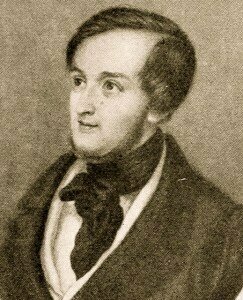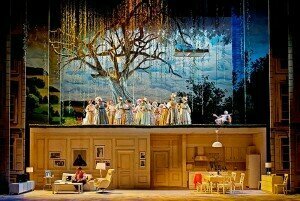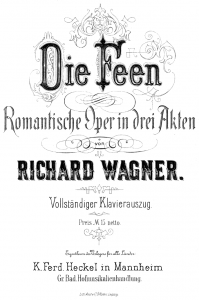
Richard Wagner
Wagner’s first operatic attempt was based on the pastoral play Die Laune des Verliebten (The Lover’s Caprice) by Johann Wolfgang Goethe. He fashioned his own libretto and subsequently composed “a scene for three female voices and a tenor aria.” Dissatisfied with his efforts, Wagner destroyed all traces of this work and wrote his next libretto for Die Hochzeit (The Wedding) in November 1832. Based on a dark medieval tale of murder and treachery Wagner also “abandoned this composition and destroyed the libretto.”

Stage Design of Die Feen
 Wagner fashioned the libretto after Carlo Gozzi’s La donna serpent (The Serpent Woman), a fairy-tale comedy that emphasized a tragic clash between the worlds of humans and of spirits. Since human beings, acting as representatives of supernatural forces, eventually triumph in a vaguely religious concept of deliverance, Wagner’s effort artistically mirrored the fervent rise of German Nationalism. Wagner’s musical language displays a heightened emphasis on orchestral color, and recognizing the importance of the recitative assigned to it an all-important role in the framework of his operas. This framework, in turn, supported a motivically rich orchestral part, and recurring themes are deliberately associated with characters and certain situations. Wagner revised the opera in 1834, but despite some rather forceful advocacy, he did not manage to secure a production.
Wagner fashioned the libretto after Carlo Gozzi’s La donna serpent (The Serpent Woman), a fairy-tale comedy that emphasized a tragic clash between the worlds of humans and of spirits. Since human beings, acting as representatives of supernatural forces, eventually triumph in a vaguely religious concept of deliverance, Wagner’s effort artistically mirrored the fervent rise of German Nationalism. Wagner’s musical language displays a heightened emphasis on orchestral color, and recognizing the importance of the recitative assigned to it an all-important role in the framework of his operas. This framework, in turn, supported a motivically rich orchestral part, and recurring themes are deliberately associated with characters and certain situations. Wagner revised the opera in 1834, but despite some rather forceful advocacy, he did not manage to secure a production. Richard Wagner: Die Feen (The Fairies)

This is excellent. Very informative abour both the history and the style of composition of the opera. Thanks to the author.